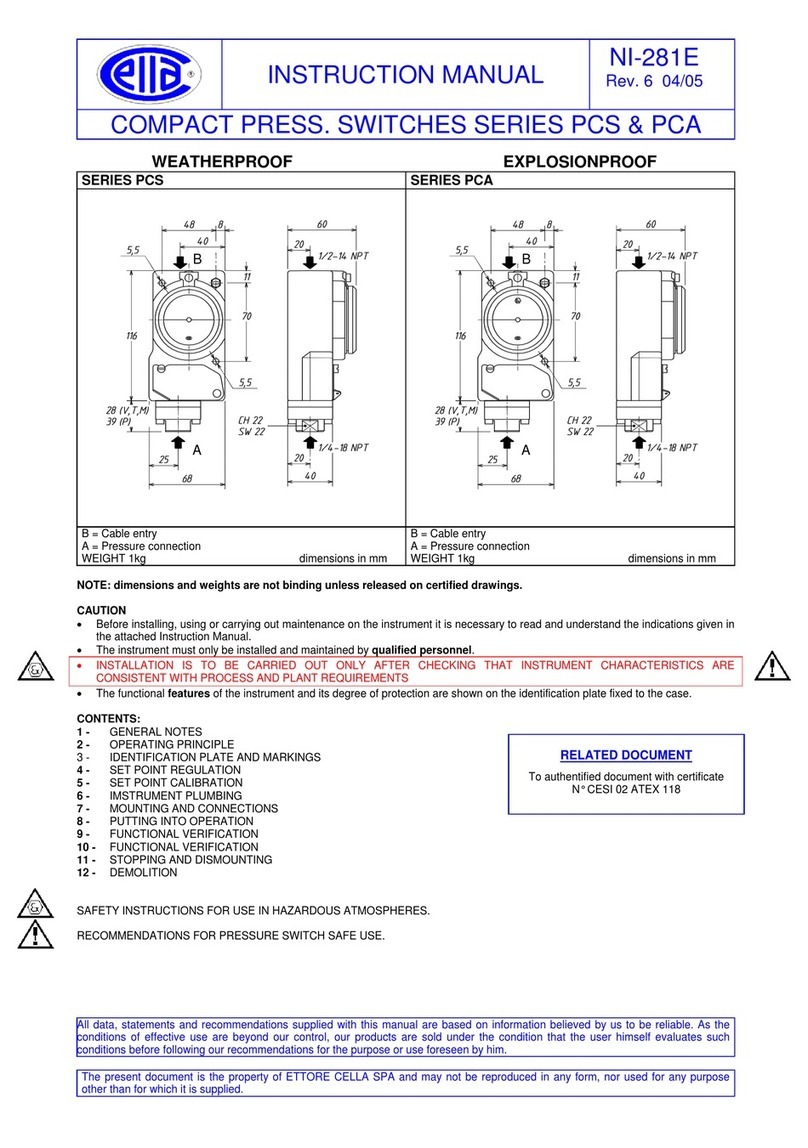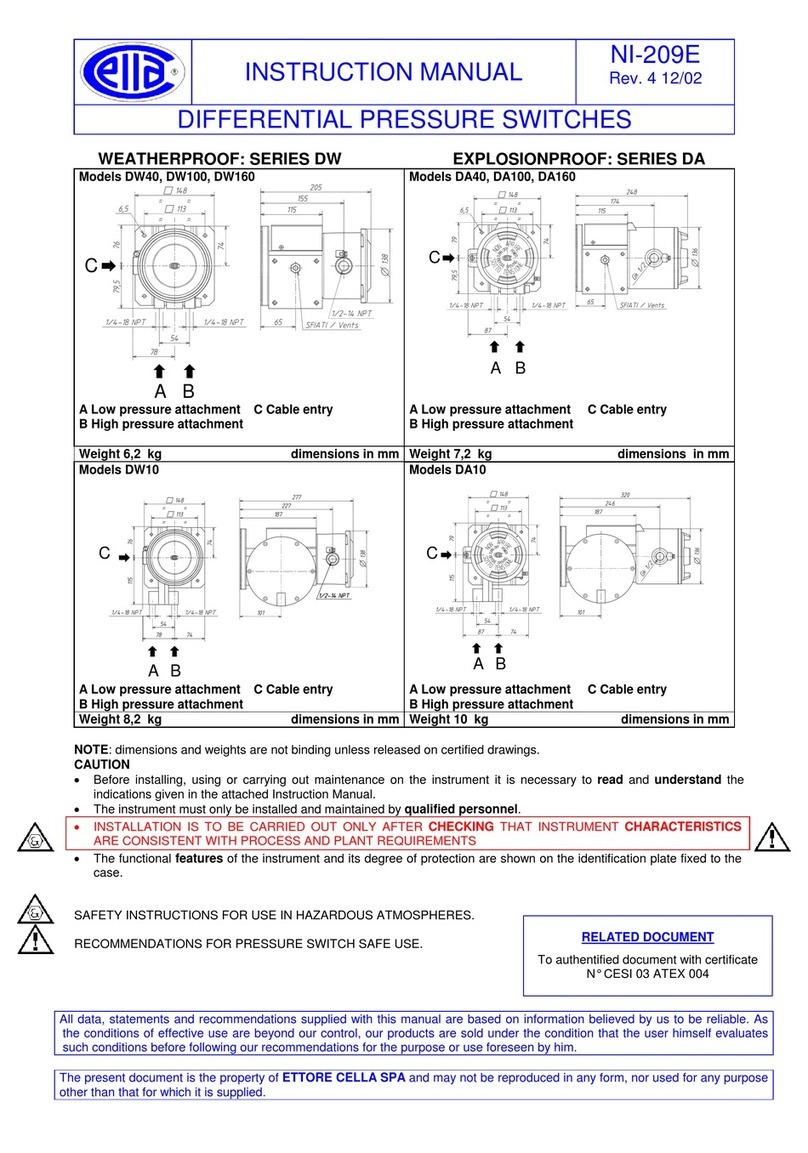INSTRUCTION MANUAL NI-222E
Rev. 2 12/09
Insert the closure plugs of the adjustment screw access
holes, block them using the internal device and if nec-
essary seal them with plumbing. Screw on the cover and
block it using the headless screw with which it is
equipped (Fig. 4).
Replace the supplied protection caps on the pressure
attachment and cable conduit.
IMPORTANT: the protection caps should only be defini-
tively removed during the connection steps (see §6).
6 - MOUNTING AND CONNECTIONS
6.1 MOUNTING
Surface mount the instrument by means of the holes
provided, or pipe mount using the appropriate bracket
(see Fig. 9). The chosen position must be such that
vibrations, the possibility of shocks or temperature
changes are within tolerable limits. The above also ap-
plies to direct mounting. With gas or vapour process
fluid, the instrument must be positioned higher than the
pipe inlet (see Fig. 8). With a liquid process fluid, the
instrument can be positioned higher or lower, indiffer-
ently (see Fig. 7 e 8). ). In this case, during set point
calibration the negative or positive head must be taken
into account (distance h in fig.7 and 8).
6.2 PRESSURE CONNECTIONS
For a correct installation it is necessary to:
Mount a shut-off valve with drain (root valve) on the
process tube to allow the instrument to be excluded and
the connection tubing to be drained. It is recommended
that said valve has a capstan-blocking device aimed at
preventing it being activated casually and without au-
thorisation.
Mount a service valve near the instrument to permit
possible functional verification on site. It is recom-
mended that the service valve is closed with a plug to
prevent the outlet of the process fluid caused by the
incorrect use of said valve.
Mount a three-piece joint onto the threaded attachment
of the instrument to permit the easy mounting or removal
of the instrument itself.
Carry out the connection using a flexible tube in such a
way that variations in the temperature of the tube itself
do not force the instrument attachment.
Ensure that all the pressure connections are airtight. It is
important that there are no leakage in the circuit.
Close the root valve and the relative drain device.
Close the service valve using a safety plug.
6.3 ELECTRICAL CONNECTIONS
It is recommended to carry out the electrical connections
according to the applicable standards. In case of explo-
sionproof instruments (Series BAX) see also the Stan-
dard EN-60079-14 and EN-61241-14. If the electrical
connection is carried out in a protected tube, it shall be
made so that condensate is prevented from entering
instrument enclosure.
The arrangement shown in Fig. 7 or 8 is therefore rec-
ommended.
CAUTION: fittings used for the electrical
connection of the pressure switch Series BAX
(explosionproof) shall be certified according to
ATEX, and shall guarantee instrument degree of
protection (IP65). To ensure anti-loosening of lock
coupling or cable gland, we suggest to seal the
thread of connection to the case with an anaerobic
sealant. For example, you can use an anaerobic
sealant type as Loctite ® 542.
Check that there is no power in the lines.
Remove the cover and carry out the cabling and connec-
tions to the terminal block (see Fig. 2).
Flexible cables with a maximum section of 1.2 mm2
(16AWG) are recommended using the pre-insulated fork
thimbles. Do not touch the adjustment screws and do
not bend the elastic microswitch supports in order to
prevent the instrument calibration being altered.
Ensure that no deposits or wire ends remain inside the
case.
As soon as connection steps are completed, mount the
cover on and make sure it is tight and blocked See Fig. 3
and 4.
6.4 SPECIAL NOTE FOR INSTALLATION OF
CATEGORY 2 G D PRESSURE SWITCHES
Explosionproof pressure switches (Series BAX)
can be installed on processes requiring apparatus
of group II category 1 in an ambient requiring
apparatus of group II category 2 (see Fig. 6).
Fig. 6 - Installation of Group II Cat. 2 GD instruments
Gas (G) Dust (D)
7 - INSTRUMENT PLUMBING
Weatherproof pressure switches (Series BWX)
The plumbing, aimed as a guarantee against possible
tampering of the calibration and electrical connections,
can be carried out using a flexible steel wire (c) inserted
into the holes in the screw (a) and the bracket (e) pro-
vided for this purpose (see Fig. 3).
Explosionproof pressure switches (Series BAX)
Plumbing is not necessary as the cover is blocked with a
headless screw, the closure plugs of the adjustment
screw access holes are blocked by means of the internal
blocking device and the instrument does not have to be
opened when installed.

























